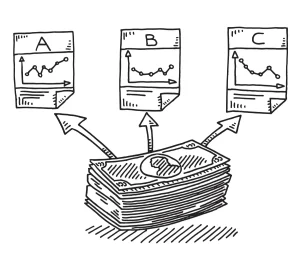Life doesn’t always follow the script—and when it goes off track, your finances often take the hit first. A hospital stay, a layoff, or even a broken water heater can quickly throw your budget into chaos. That’s where personal risk management comes in: it’s about getting ahead of problems before they turn into crises.
Rather than reacting when things go wrong, you prepare while they’re still going right. Personal risk management helps you spot vulnerabilities in your finances and put safeguards in place. The goal isn’t to predict the future—it’s to be ready when it surprises you.
Understanding personal risk management

Think of personal risk management as a strategy to soften life’s financial blows and create long-term stability. It means recognizing the risks you face—like medical costs, job instability, or property damage—and having a plan to deal with them. It’s not about fear; it’s about control and readiness.
When you take the time to prepare, you reduce the pressure of future uncertainty and gain valuable clarity. You make better decisions, avoid panic spending, and recover faster from setbacks that might otherwise linger. And the peace of mind that comes from knowing you’re covered? That’s just a bonus.
Why risk management builds financial confidence
Personal risk management gives you a clear edge: confidence in uncertain times. When you know your finances can handle a storm, you’re free to focus on opportunity, not survival. It transforms anxiety into clarity and helps you act thoughtfully even when things don’t go as planned.
The most common financial risks people face
Some surprises are more common than others. Most people, at some point, deal with a job loss, medical bill, home repair, or legal issue. These can strain even a solid budget, especially if they hit all at once—or at the worst possible time, without warning.
That’s why identifying your biggest financial threats is a smart first move. When you know what could go wrong, it’s easier to build defenses that actually work. You don’t have to be perfect—just prepared enough to stay steady when life throws a curveball your way.
| Financial Risk | Example Scenario | Financial Impact | Defense Strategy |
|---|---|---|---|
| Medical Emergency | Surgery or illness | High out-of-pocket costs | Health insurance, HSA, emergency fund |
| Job Loss | Company layoffs | Loss of income | Emergency fund, unemployment benefits |
| Property Damage | Burst pipe or fire | Repair or replacement costs | Homeowners/renters insurance |
| Lawsuit or Liability | Accident or contract dispute | Legal fees or fines | Umbrella policy, legal services plan |
Emergency funds: your first line of defense
An emergency fund isn’t just a smart idea—it’s your safety net. It keeps you from spiraling into debt when life catches you off guard. Whether it’s a blown transmission or a dental emergency, having that money set aside means fewer tough choices under pressure or emotional strain.
You don’t need to save it all at once. Start where you can—even a few dollars a week adds up quickly. Aim for three to six months of essentials, like rent, food, and transportation. That way, if your income stops, your life doesn’t have to pause completely.
Emergency funds turn chaos into control
A financial emergency doesn’t have to spiral into a long-term crisis. With cash on hand, you gain control over your response, stay calm, and avoid compounding problems. Instead of turning to high-interest debt, you rely on your own preparation and stability.
Insurance: transferring risk to a safety net
Insurance doesn’t stop bad things from happening—but it keeps them from wrecking your finances entirely. For a monthly cost, you shift the burden of big risks to a company that’s built to handle them properly. That trade-off can save you thousands when the unexpected hits out of nowhere.
To make it work, you must understand what each policy covers and what it doesn’t include. Regularly review your coverage to match your evolving lifestyle and financial needs as they change. This is where personal risk management shifts from theory to practice—giving you protection that adapts to real change.
| Type of Insurance | Purpose | Who Needs It | What to Watch Out For |
|---|---|---|---|
| Health Insurance | Covers medical bills | Everyone | Deductibles, co-pays, exclusions |
| Auto Insurance | Covers vehicle damage/liability | Vehicle owners | Collision vs. comprehensive coverage |
| Homeowners/Renters | Covers property damage, theft, liability | Property owners and tenants | Coverage limits, personal property |
| Life Insurance | Supports family after death | Parents, spouses, caregivers | Policy length, beneficiaries |
Creating your personal risk management plan
A personal risk management plan doesn’t have to be fancy—it just has to be honest and realistic. Start by listing the risks that matter in your life. Are you the sole income earner? Do you live in a flood zone? Are your savings thin? Write it all down with as much detail as possible.
Then figure out how to address each one. Maybe you boost your emergency fund or review your car insurance policy. Maybe you finally create that will or look into disability coverage. The idea is to build a simple, personal playbook so you’re not starting from zero when things get tough or unpredictable.
Tailored protection offers real results
No two lives are identical—so no two risk management plans should be. The more your plan reflects your real world, the better it works under pressure. And the more consistently you update it, the stronger and more useful it becomes for navigating the unexpected.
Risk management isn’t just for high earners
Risk hits everyone, but the less you earn, the more damage it can do quickly. That’s why people with modest incomes often need personal risk management even more urgently. A single hospital visit or missed paycheck can unravel everything if you’re not ready or protected in advance.
You don’t need wealth to prepare—just a willingness to start where you are. That might mean saving a little, shopping smarter for insurance, or getting help organizing your finances. The important thing is to do something. Every step adds up and builds resilience over time.
Resilience is built, not bought
Preparedness is a habit, not a privilege. As you build it, you gain strength—not just financially, but mentally too. Personal risk management gives you both. It puts you in control, helping you act strategically instead of fearfully when life throws something unexpected your way.



